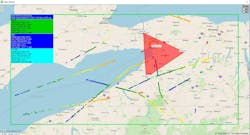ADELPHI, Md. – U.S. Army researchers are approaching industry for autonomous unmanned passive geolocation technology to detect and pinpoint RF emitters such as integrated air-defense radars, unmanned aerial vehicle (UAV) communications links, electronic warfare (EW) jammers, and control stations.
Officials of the Army Contracting Command Aberdeen Proving Ground annex in Adelphia, Md., issued a request for information (W911QX24Q0112) Wednesday for one autonomous unmanned passive geolocation system.
Army researchers want to acquire an autonomous unmanned RF-based passive geolocation system that can operate in all-visibility conditions.
The geolocation system also should have an RF multi-band payload weight of less than 7.7 pounds, offer low size, weight, and power consumption (SWaP); robust localization capability; wide area RF surveillance; an open-architecture design; and control one or many unmanned aircraft.
Related: The sensor- and signal-processing challenges of electronic warfare
Scientists in the past, for example, have used autonomous unmanned passive geolocation systems to control swarms of UAVs that are trying to detect, locate, and classify enemy fire-control and air-defense radar systems.
Companies interested should email capability statements no later than 22 April 2024 -- 10 days from now -- to the Army's Swati Jain at [email protected].
Email questions or concerns to the Army's Swati Jain at [email protected]. More information is online at https://sam.gov/opp/186375531815433aa74d74a960604e01/view.



